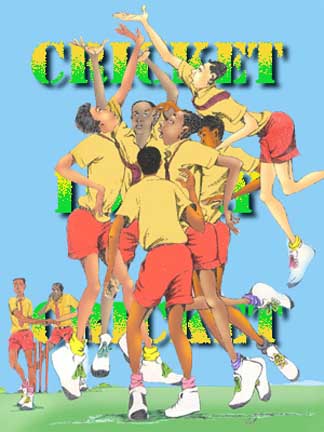

I was rather late in joining that huge club of frowning,
pocket-radio listening, statistic-keeping, excitable folks who exist
under the broad banner of ‘cricket fans.’ The names Gary Sobers, Rohan
Kanhai, Wes Hall, Charlie Griffith, Lance Gibbs, Deryck Murray, and
Charlie Davis were more well-known than that of our Prime Minister.
Actually, it was a time when West Indies cricket was in a bit of a
slump. Except for the latter two, the above mentioned gentlemen of
bat-and-ball were past their prime and our cricket team was but a
shadow of that potent group of the Fifties and early Sixties which also
included great cricketers like Frank Worrel, Solomon, Hunt, Butcher,
Weeks, Walcott, Alexander, Ramadin, Valentine and Clyde Walcott. It was
an era when all of us little boys pretended to be one of these
cricketers when we played cricket down the street. Whenever there was a
series on you could’ve heard radios playing loudly in the
neighbourhood. When you didn’t hear the loud broadcast then you knew
the players were in for lunch, or tea, or play was stopped because of
bad light or rain. Men and women rode bicycles, sat in buses, or walked
on the streets with pocket radios glued to an ear. Those unfortunate
slobs like myself who were too young, careless, or poor to own a pocket
radio, were reduced to frequently asking listeners for the score or
parking ourselves periodically by houses that blasted the commentary to
the neighbourhood. The expressions on the faces of listeners usually
told you if the West Indies were doing well or not.
When I caught the cricket-listening bug at age twelve or thereabout
Gary Sobers was still the captain of the team. We were in the process
of shedding the old
‘greats’ and desperately looking for new talent. One of the new kids on
the block was a bespectacled tall young fellow who looked more suited
for standing before a class of uniformed students explaining the
implications of ‘x’ plus ‘y’ minus ‘z.’ The lens of his spectacles
looked like the kind that starts fires if hit at the right angle by
sunlight. To made matters worse was his picture appeared in the
newspapers with the unimpressive name of ‘Clive Lloyd’ typed beneath
it. My second impression was that our team had reached rock bottom and
was scraping the barrel. My first was that this lad couldn’t see a
football if that was being bowled at him. But the gentleman kept
posting scores of 69 not out, and 148. At first I wondered if the
English, Indian, and Australian bowlers were getting soft. After
posting a steady stream of scores like that I was firm in my confidence
in him. Then there was a bow-legged gentleman named Basil Butcher. He
was a home-grown chap who liked to hog the wicket. We had a couple of
fellows like that down my street who were firm believers in occupying
the crease until their mothers called them, or someone beat them up and
chased them home. The flamboyant Rohan Kanhai was still wielding a
potent bat. Our opening batsman was a new lad named Roy Fredericks. He
was of the school of opening batsmen who were of the opinion that the
Number Six batsman must not reach him at the crease. He had no respect
for opposing fast bowlers regardless of whom it was. If the first ball
of an innings was bad he gave it the full treatment. As long as he was
at the crease the boys who changed the score on the scoreboard at the
cricket ground were busy. At the opposite end of the crease was a slew
of openers being tried until Gordon Grenidge came along. Our wicket
keeper was a little Trinidadian named Deryck Murray who looked even
smaller when I saw him in real life at Bourda ground. I found it
difficult to comprehend that this was the larger than life figure who
plunged and snapped up those barely visible balls that flew by the
batsman or off the edge of the bat. His batting was pretty solid too.